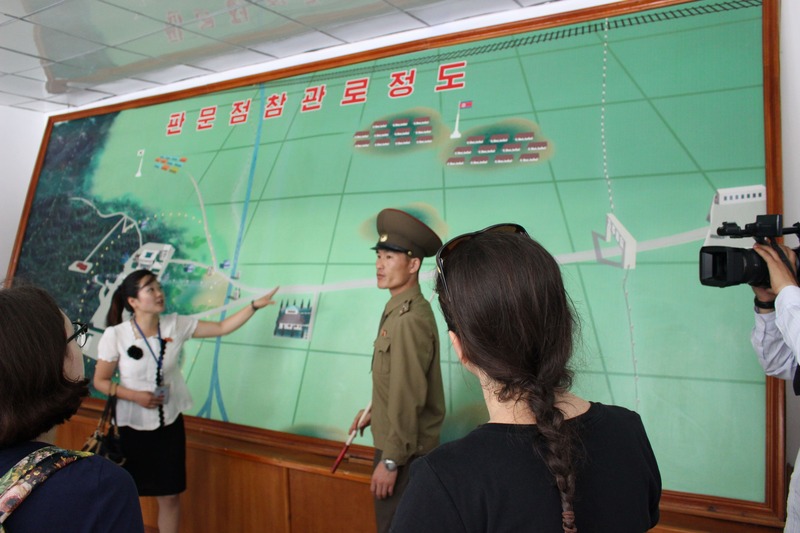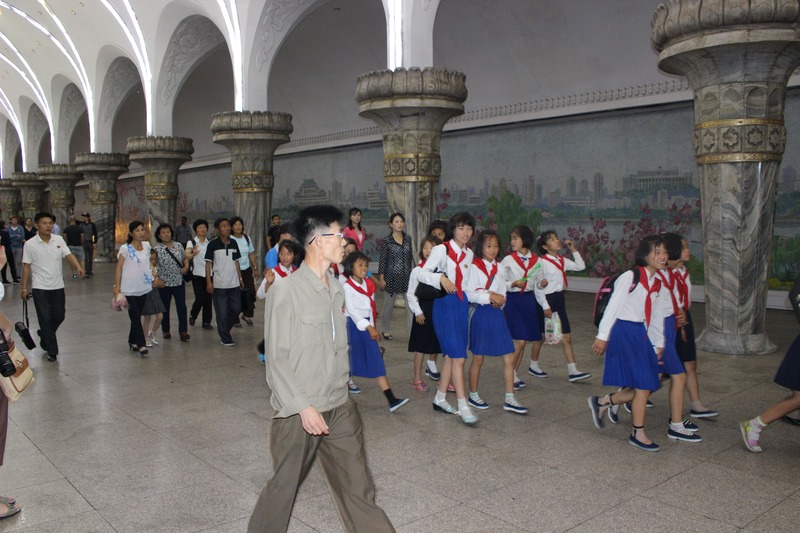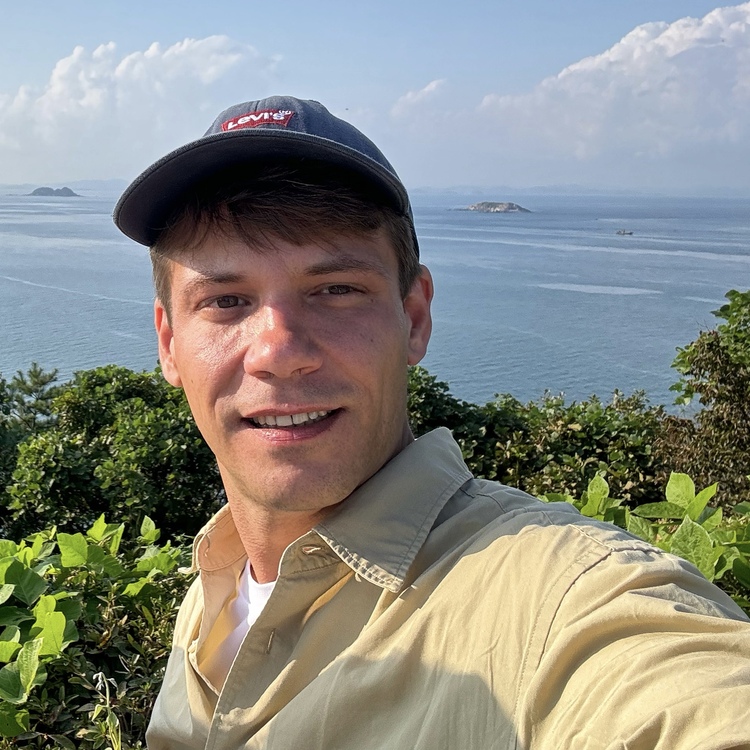Driving South to the DMZ, North - South korean border.
This is part of a series where Koryo Tours' Greg recounts his first trip to North Korea.
Click here for Part 1 and Part 2, or jump ahead to Part 4.
The Ancient Capital that Survived the War
Kaseong lies just south of the 38th parallel.
Before the Korean War (1950-1953) it belonged to the South. As a result, it survived the US Air Force bombings that destroyed the rest of the country and remained intact throughout the war.
Today Kaseong is a frontier city but once was the capital of Korea from the first year of the Koryo Dynasty (919-1392) until the second year of the Joseon Dynasty in 1394 when the capital was moved to what is known today as Seoul.
Kaesong Sites
Kaesong is home to several UNESCO World Heritage sites.
This includes the Mausoleum of King Wangon the founder of the Koryo Dynasty and Sonjuk Bridge which had a pivotal role in the ending of that dynasty.
The city also has a nice little Old Town that is a living museum of pre-division Korea. Quasi the Hanok village of the DPRK.
We started our day with a walk in the Old Town from our hotel to the South Gate.
As we were warned before the tour that photography outside the capital is more restricted I asked Mr. Pak if I could take photos of city life while we were walking, he responded with a smile and the most natural tone: "Of course, why not?" as if I asked the silliest question with the only obvious response.
From there we rode our bus to Sonjuk Bridge. This 13th-century bridge is the sight where the last loyal statesman of the Koryo Dynasty, Jong Mong Ju was assassinated in 1392.
This incident marked the symbolic end of the Koryo Dynasty giving way to the new and last dynasty of Korea, the Joseon Dynasty.
Mr. Ri, is that you?
The Joseon Dynasty was established by Ri Song Gye and Jong Mong Ju was assassinated by his son.
When on tour in 2019 our guide was called Mr. Ri he told us that he was afraid that he was a descendant of this particular Ri (Mr. Ri used a less presentable phrase to define which Ri he was talking about) as the founding of the Joseon Dynasty is considered as a treacherous act in the DPRK.
Luckily for him, they are not related by blood.
But when I was on tour in the South and we visited the Korean War Memorial, our volunteer museum guide proudly introduced herself as the n-generation descendant of the founder of the Joseon Dynasty, Ri Song Gye.
It is amazing how you can hear the same story (even the less widely known ones) from such different perspectives on the respective sides of the DMZ.
Our next stop was the Koryo Museum or as it is known on the UNESCO World Heritage list, Sungyang Academy.
Built in the 10th century and once a Confucian academy it displays artefacts from the period of the Koryo Dynasty. To be honest, the museum itself reminded me of a mediocre village-level local history museum in Hungary.
Next to the Koryo Museum is a stamp shop selling postcards and propaganda posters.

The smile of Kaesong. Art students at Sonjuk Bridge.
The DMZ, Panmunjom, and the JSA
And then came the visit to the DMZ.
First, we drove to a waiting area and souvenir shop where the briefing also took place in front of a map of the divided Korean Peninsula and of the Joint Security Area.
The briefing is conducted by one of the officers of the Korean People's Army and translated by our guide.
From here we entered the military-restricted area in line one by one and got back on our bus joined by soldiers.

Panmunjom Briefing. Notice the South Korean flag on the upper left. Later it was painted over with white paint around 2018.
Panmunjom Peace Village
Our first stop was Panmunjom Peace Village where the peace negotiations and the signing of the armistice took place.
The negotiations took place in a smaller building while the signing of the armistice in a 200 m2-large hall that according to the North Korean narrative was built within 48 hours. The story behind this is that supposedly the Americans wanted to sign the armistice in a tent so that there would be no physical evidence of their humiliating defeat.
By the way, here we were told that the US provoked the Korean War, the verb started was not used.
During the time of our visits there was also what back then I believed was a North Korean high school group visiting. In retrospect, they must have been a Chongryon (Korean residents of Japan) group on their "birthright trip" to the Motherland.
On the way to Panmun Pavilion and Conference Row, we stopped at a giant signature of Kim Il Sung. The narrative has it that just a day before his passing on July 7th 194 the Eternal President signed a groundbreaking document about the reunification of Korea. Everyone is curious about its fate now that Kim Jong Un deemed reunification impossible and named the ROK as the DPRK's primary foe.
And then came the supposed highlight that was a disappointment for the first time. The JSA.
The JSA (Blue Huts)
By no means I visited the DPRK on a catastrophe tourism agenda but I had certain images in my head about the JSA. Especially because at that time my favourite movie was Joint Security Area telling the story of the unlikely friendship between two Northern and two Southern soldiers serving there.
First, I imagined it to be way bigger.
Second, I thought that KPA soldiers and ROKA MPs are gazing at each other along the demarcation line.
It was small, no gazing contest, and the Southern side was completely deserted.
Later I learned that the soldiers of the respective sides were only present when there were visits on their side.
But we could enter one of the blue huts on Conference Row that is administered by the UN.
After our JSA visit, we had a traditional Korean royal lunch (pangsanggi) at a local restaurant.
Back in Pyongyang
Lunch was followed by a 3-hour long drive back to Pyongyang with a rest stop halfway.
Pyongyang Metro
After arriving in Pyongyang, we took the metro. Pyongyang has two subway lines, one East-West Line and one North-South Line. The latter was the first to open in 1973.
The subway was built on the Soviet model, especially the one in Moscow, and is one of the deepest subway systems in the World. I
t also serves as a nuclear bunker. The distance between stations is longer than in most cities that I visited before. The stations are characterized by representative, socialist realist paintings and sculptures.
Before 2010, tourists could visit the two most representative stations. We got on the subway at one of these stations (Yonggwang/Glory) and got off at the Kaeson (Triumphant Return) station, at the Arch of Triumph. I haven't taken such a long escalator in one direction since visiting St. Petersburg.
In theory, it takes 3 and a half minutes to get down or up. Just like in the capital of the revolution, the staff here are in military-style uniforms.
Music plays from the loudspeakers on the metro carriages, and the portraits of the leaders smile at the people. Apart from one new train made in North Korea (it's really just a local facelift of the older ones), the line is run by old East Berlin trains. There is no passenger information on the trains to tell you about the stations and there are no announcements either. People were playing games on their phones.

In the Pyongyang Metro
Kaeson Station
At Kaeson Station ticket gates were already installed. By August 2017, they could be found at all stations.
I reluctantly admit that I liked the free toilet at the station the best.
As we exited the station, we took photos of The Arch of Triumph and then drove to East Pyongyang to the Party Foundation Monument.
The 50-meter-tall monument was built in 1995 to mark the 50th anniversary of the founding of the Workers' Party of Korea. Behind the monument stands two buildings symbolizing red flags with the slogan "forever victorious" on top of them. The sickle (peasantry), the hammer (workers) and the brush (intellectuals) symbolise the three pillars of Korean society.
It is somewhat different from how the socialist society was imagined in Hungary. We had two classes (workers and the peasantry) and one starts (the intellectuals).
North Korean Beer & End of The Day
Our next stop was Taedonggang Beer Bar No. 3. Here they serve locally brewed beers including rice beer and coffee beer.
It was a very cosy place. There were a couple of locals as well and in the background they were broadcasting some kind of figure skating championship. This here where I realized that Hungary (Magyarország) is referred to as "Majyaru" in the DPRK based on Hungary's native name.
Here I had another conversation with Mr. Pak who asked me about my thoughts on the DPRK's nuclear program and the daily sight of soldiers. Politics was followed by a couple of personal topics about Mr. Pak's life and family. I also learned that summer vacation is two weeks in high school and one month in lower grades.
North Korean Dinner
Our dinner was at the hot-pot restaurant where the waitresses treated us to a live performance.
After dinner - now in the rain.
We took a short stroll in one of the new districts of Pyongyang called Mirae (Future) Scientists' Street. The buildings on this street predominantly house the employees of the technical university.
Our hotel for that night was again the Yanggakdo International Hotel.
